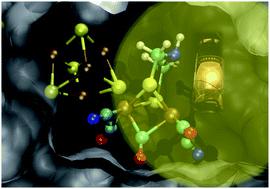当前位置:
X-MOL 学术
›
Sustain. Energy Fuels
›
论文详情
Our official English website, www.x-mol.net, welcomes your
feedback! (Note: you will need to create a separate account there.)
Photochemistry and photoinhibition of the H-cluster of FeFe hydrogenases
Sustainable Energy & Fuels ( IF 5.0 ) Pub Date : 2021-07-20 , DOI: 10.1039/d1se00756d Matteo Sensi 1, 2, 3 , Carole Baffert 2 , Vincent Fourmond 2 , Luca de Gioia 3 , Luca Bertini 3 , Christophe Léger 2
Sustainable Energy & Fuels ( IF 5.0 ) Pub Date : 2021-07-20 , DOI: 10.1039/d1se00756d Matteo Sensi 1, 2, 3 , Carole Baffert 2 , Vincent Fourmond 2 , Luca de Gioia 3 , Luca Bertini 3 , Christophe Léger 2
Affiliation

|
Hydrogenases are enzymes that catalyze the oxidation and production of molecular hydrogen. For about fifteen years, there have been many reports about the successful connection of these enzymes to photosensitizers with the aim of designing H2 photoproduction systems, but relatively little attention has been paid to whether and why illumination may affect the catalytic properties of the enzyme. In all hydrogenases, hydrogen activation occurs at an inorganic active site that includes at least one Fe–carbonyl motif, which may make it sensitive to irradiation. Here we review the evidence that hydrogenases are indeed photosensitive. We focus mainly on the so-called FeFe hydrogenases; their active site, called the H-cluster, consists of a [4Fe4S] cluster that is bound by a cysteine sulfur to a diiron site. The iron atoms of the binuclear cluster are coordinated by carbonyl and cyanide ligands and an azadithiolate group. We describe the effects of UV-visible light irradiation on the enzyme under cryogenic or turnover conditions and the photoreactivity of model complexes that mimic the diiron site. We emphasize the dependence of the photochemical processes on wavelength, and warn about FeFe hydrogenase photoinhibition, which should probably be considered when attempts are made to use FeFe hydrogenases for the artificial photosynthesis of solar fuels. We also underline the relevance of studies of synthetic mimics of the H-cluster for understanding at atomistic level the photochemical processes observed in the enzyme.
中文翻译:

FeFe氢化酶H簇的光化学和光抑制
氢化酶是催化氧化和产生分子氢的酶。大约十五年来,有许多关于这些酶与光敏剂成功连接的报道,目的是设计 H 2光产生系统,但相对较少关注光照是否以及为什么会影响酶的催化特性。在所有氢化酶中,氢活化发生在包含至少一个 Fe-羰基基序的无机活性位点,这可能使其对辐射敏感。在这里,我们回顾了氢化酶确实具有光敏性的证据。我们主要关注所谓的 FeFe 氢化酶;它们的活性位点称为 H 簇,由 [4Fe4S] 簇组成,该簇通过半胱氨酸硫与二铁位点结合。双核簇的铁原子由羰基和氰化物配体以及氮杂二硫醇基团配位。我们描述了紫外可见光照射在低温或周转条件下对酶的影响,以及模拟 diiron 位点的模型复合物的光反应性。我们强调光化学过程对波长的依赖性,并警告 FeFe 氢化酶光抑制,当尝试使用 FeFe 氢化酶进行太阳能燃料的人工光合作用时,可能应该考虑这一点。我们还强调了研究 H 簇的合成模拟物对于在原子水平上理解酶中观察到的光化学过程的相关性。当尝试使用 FeFe 氢化酶进行太阳能燃料的人工光合作用时,可能应该考虑这一点。我们还强调了研究 H 簇的合成模拟物对于在原子水平上理解酶中观察到的光化学过程的相关性。当尝试使用 FeFe 氢化酶进行太阳能燃料的人工光合作用时,可能应该考虑这一点。我们还强调了研究 H 簇的合成模拟物对于在原子水平上理解酶中观察到的光化学过程的相关性。
更新日期:2021-08-05
中文翻译:

FeFe氢化酶H簇的光化学和光抑制
氢化酶是催化氧化和产生分子氢的酶。大约十五年来,有许多关于这些酶与光敏剂成功连接的报道,目的是设计 H 2光产生系统,但相对较少关注光照是否以及为什么会影响酶的催化特性。在所有氢化酶中,氢活化发生在包含至少一个 Fe-羰基基序的无机活性位点,这可能使其对辐射敏感。在这里,我们回顾了氢化酶确实具有光敏性的证据。我们主要关注所谓的 FeFe 氢化酶;它们的活性位点称为 H 簇,由 [4Fe4S] 簇组成,该簇通过半胱氨酸硫与二铁位点结合。双核簇的铁原子由羰基和氰化物配体以及氮杂二硫醇基团配位。我们描述了紫外可见光照射在低温或周转条件下对酶的影响,以及模拟 diiron 位点的模型复合物的光反应性。我们强调光化学过程对波长的依赖性,并警告 FeFe 氢化酶光抑制,当尝试使用 FeFe 氢化酶进行太阳能燃料的人工光合作用时,可能应该考虑这一点。我们还强调了研究 H 簇的合成模拟物对于在原子水平上理解酶中观察到的光化学过程的相关性。当尝试使用 FeFe 氢化酶进行太阳能燃料的人工光合作用时,可能应该考虑这一点。我们还强调了研究 H 簇的合成模拟物对于在原子水平上理解酶中观察到的光化学过程的相关性。当尝试使用 FeFe 氢化酶进行太阳能燃料的人工光合作用时,可能应该考虑这一点。我们还强调了研究 H 簇的合成模拟物对于在原子水平上理解酶中观察到的光化学过程的相关性。











































 京公网安备 11010802027423号
京公网安备 11010802027423号